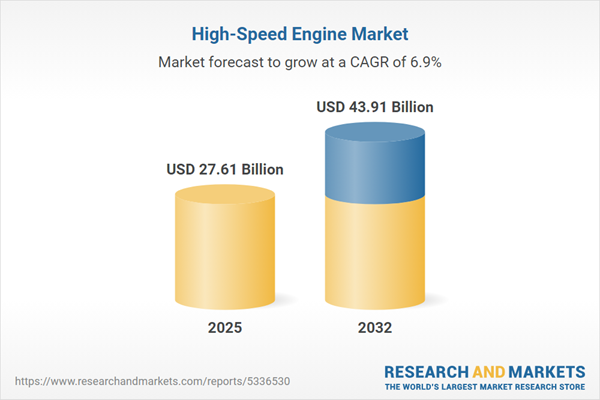Speak directly to the analyst to clarify any post sales queries you may have.
The high-speed engine market is rapidly evolving, shaped by shifting regulations, technological advances, and mounting operational demands. Senior leaders must prioritize modernization and compliance to ensure their organizations remain agile and competitive in a complex global landscape.
Market Snapshot: High-Speed Engine Market Size and Growth
In 2024, the high-speed engine market reached USD 25.80 billion, with projections indicating growth to USD 27.61 billion by 2025 and a compound annual growth rate (CAGR) of 6.87%. By 2032, the sector is expected to approach USD 43.91 billion. Ongoing advancements in engine architecture and emission controls are fueling continued demand. These developments help organizations respond to changing compliance requirements and accelerated digital transformation across industrial sectors. Industry players are adopting flexible business models and optimizing resource allocation while targeting both established and high-growth regions. This focus ensures operational efficiency and reinforces resilience amid evolving market forces.
Scope & Segmentation: High-Speed Engine Market
- Applications: High-speed engines serve diverse sectors such as aerospace, automotive, marine transport, oil and gas, industrial manufacturing, and power generation. Each industry segment emphasizes application-specific demands for reliability, safety, and regulatory compliance.
- Fuel Types: The market includes diesel, gasoline (rotary and spark ignition), and natural gas engines. Fuel selection supports environmental objectives and tailored performance standards across various industry sectors.
- Engine Configurations: Inline, opposed, radial, and V-type engines (including V12, V8, and V6) meet requirements for space, efficiency, and technical regulations in distinct applications.
- Core Technologies: Organizations implement naturally aspirated and turbocharged solutions, with both single and twin-turbo systems. These address demands for higher efficiency and emissions management in critical markets.
- Distribution Channels: Products are primarily delivered via original equipment manufacturers (OEMs) and aftermarket suppliers. This dual channel approach promotes asset longevity and ongoing technical support for sector-specific requirements.
- Regional Markets: The Americas, EMEA (Europe, Middle East, and Africa), and Asia-Pacific all require locally adapted solutions. North, Central, and South America necessitate tailored compliance strategies, while EMEA features both mature and dynamic regulatory environments. Asia-Pacific markets like China, India, Japan, South Korea, and Southeast Asia drive demand for region-specific products responding to unique regulations and customer preferences.
- Key Companies: Leading industry organizations—including Cummins Inc., Caterpillar Inc., Rolls-Royce Power Systems AG, MAN Energy Solutions SE, Wärtsilä Corporation, Volvo Penta AB, Mitsubishi Heavy Industries, DEUTZ AG, Yanmar Co., Ltd., and Doosan Infracore Co., Ltd.—prioritize customer-centric innovation and set competitive benchmarks through consistent R&D and engagement efforts.
Key Takeaways for Senior Decision-Makers
- Leveraging advanced manufacturing techniques such as additive manufacturing and specialized alloys supports longer engine lifecycles and enhanced cost control throughout asset deployment.
- Digital twin technologies and predictive analytics drive improvements in product development, maintenance, and operational reliability, particularly for mission-critical applications.
- Improved collaboration between component suppliers and OEMs accelerates the adoption of emerging technologies and smooths entry into diverse global markets.
- Directing research and development to meet evolving emission requirements paves the way for alternative propulsion adoption, especially in environmentally sensitive jurisdictions.
- Prioritizing modular designs and integrating digital systems ensures organizations can pivot efficiently in response to regulatory changes and shifting customer demand.
Tariff Impact: Navigating the 2025 U.S. Tariff Shifts
Forthcoming changes to U.S. tariffs on high-speed engine components in 2025 require proactive adaptations in sourcing and procurement. Building robust domestic supply chains and implementing automation within manufacturing are critical steps to preserve competitiveness. Adjusting inventory management methodologies enhances organizational resilience, equipping companies to navigate the challenges presented by updated regulatory and market conditions.
Methodology & Data Sources
This analysis is grounded in direct interviews with senior executives and comprehensive secondary research. Analytical frameworks—including SWOT assessments, Porter’s Five Forces, and scenario analysis—provide in-depth perspectives on the technical, regulatory, and market dynamics shaping the high-speed engine sector.
Why This Report Matters for Senior Leaders
- Offers structured segmentation and actionable insights, empowering executives to drive informed decision-making through industry changes.
- Supports the development of risk mitigation and supply chain strategies, strengthening resilience amid evolving policy landscapes.
- Highlights untapped market opportunities, enabling leadership to make targeted investments for sustainable growth.
Conclusion
Sustained advancement in the high-speed engine market relies on embracing innovation, adopting advanced technologies, and strengthening industry collaboration. This report delivers the intelligence required for leadership teams to guide their organizations successfully through change.
Additional Product Information:
- Purchase of this report includes 1 year online access with quarterly updates.
- This report can be updated on request. Please contact our Customer Experience team using the Ask a Question widget on our website.
Table of Contents
3. Executive Summary
4. Market Overview
7. Cumulative Impact of Artificial Intelligence 2025
Companies Mentioned
The companies profiled in this High-Speed Engine market report include:- Cummins Inc.
- Caterpillar Inc.
- Rolls-Royce Power Systems AG
- MAN Energy Solutions SE
- Wärtsilä Corporation
- Volvo Penta AB
- Mitsubishi Heavy Industries, Ltd.
- DEUTZ AG
- Yanmar Co., Ltd.
- Doosan Infracore Co., Ltd.
Table Information
| Report Attribute | Details |
|---|---|
| No. of Pages | 184 |
| Published | November 2025 |
| Forecast Period | 2025 - 2032 |
| Estimated Market Value ( USD | $ 27.61 Billion |
| Forecasted Market Value ( USD | $ 43.91 Billion |
| Compound Annual Growth Rate | 6.8% |
| Regions Covered | Global |
| No. of Companies Mentioned | 11 |









